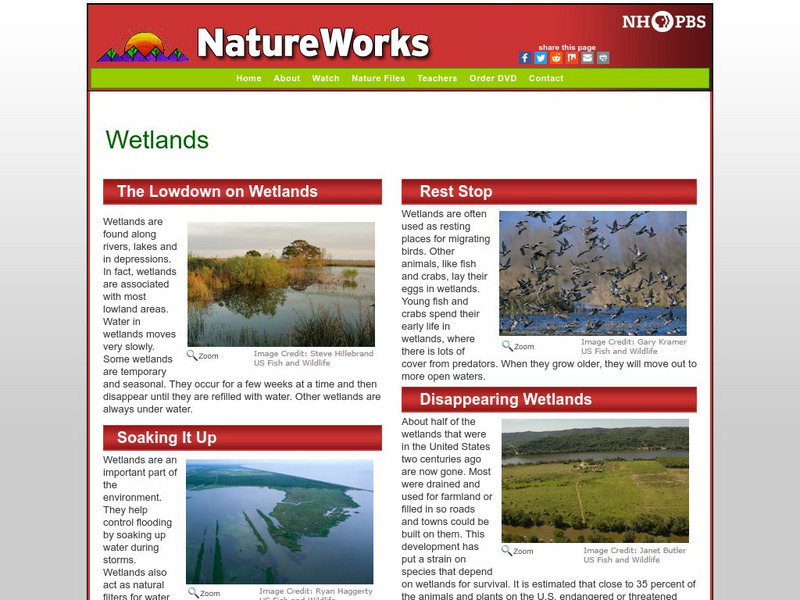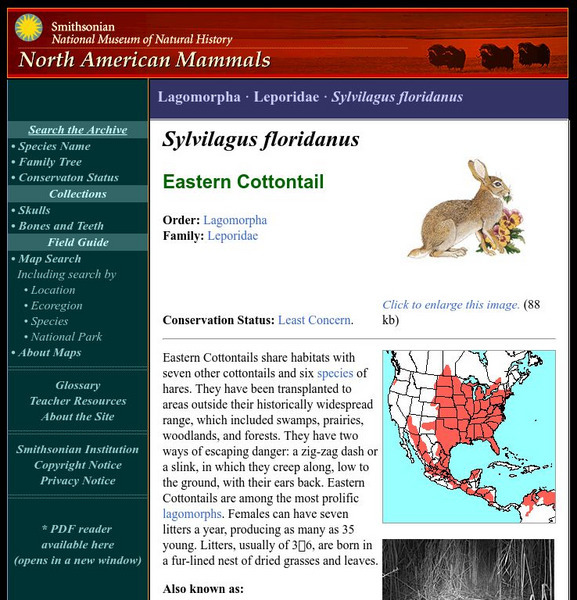Black Past
Black Past: Washington, Henry
An interesting, but brief encyclopedia article about Henry Washington, one of George Washington's slaves, who fought for the British.
PBS
Nh Pbs: Nature Works: Wetlands
Did you know that wetlands are frequently used as resting stops for migrating birds? This is just one of the many interesting facts found within this educational resource. This site features information on the characteristics, types,...
PBS
Nh Pbs: Nature Works: Ponds
Can you give a definition for a pond? This site provides information ranging from types of plants living in ponds to how ponds were formed. Don't miss out on the photographs found within the site too.
Curated OER
University of Texas: Botswana: Map
A small map of Botswana that shows the Okavango River and delta as well as the salt pans. From the Perry-Castaneda Collection.
Houghton Mifflin Harcourt
David Weisner: Why Frogs? Why Tuesday
Where did David Weisner get the idea for Tuesday? Did he have a pet frog growing up? Did he live near a swamp? David Wiesner answers these questions as you read through his Caldecott Medal acceptance speech for Tuesday on this...
Smithsonian Institution
National Museum of Natural History: American Mammals: Bobcat
The Bobcat is the most widely distributed native cat in North America. Bobcats occupy many habitat types, from desert to swamp to mountains. Learn more about the Lynx rufus, more commonly known as a Bobcat, in this easy-to-read species...
Smithsonian Institution
National Museum of Natural History: American Mammals: Snowshoe Hare
The Snowshoe Hare is broadly distributed in the north from coast to coast and occurs in a variety of habitat types, including swamps, hardwood forests, and mixed and evergreen forests. Nocturnal like most members of the family, this hare...
Smithsonian Institution
National Museum of Natural History: American Mammals: Marsh Rabbit
Marsh Rabbits live only in marshy areas, and like Swamp Rabbits, are good swimmers. They are often found in habitats with pools of brackish water and plants such as cattails, water hyacinth, rush, centella, and marsh pennywort. Learn...
Smithsonian Institution
National Museum of Natural History: American Mammals: Eastern Cottontail
Eastern Cottontails share habitats with seven other cottontails and six species of hares. They have been transplanted to areas outside their historically widespread range, which included swamps, prairies, woodlands, and forests. Learn...
National Audubon Society
National Audubon Society: Audubon Adventures: Ohio's Wetland Wonderland [Pdf]
This is a well developed lesson plan on Ohio's wetlands. This resource includes comprehensive information, an assessment, and supporting pictures. The resource is in PDF form.
Travel Document Systems
Tds: Sierra Leone: Geography
A graphic showing the various aspects of Sierra Leone's physical environment. Find out about the climate, terrain, natural resources, and environmental concerns. Information is from the CIA World Fact Book.
ClassFlow
Class Flow: South Carolina Revolutionary War Heroes
[Free Registration/Login Required] This flipchart covers Revolutionary War heroes Thomas Sumter, Andrew Pickens, and Francis Marion.
Curated OER
Educational Technology Clearinghouse: Maps Etc: Animals of Asia, 1906
A pictorial map from 1906 illustrating the various animals that live in regions of Asia. "The white bear, the seal and many sea birds are found near the Arctic shore. In the cold parts of Siberia tribes of yellow people keep herds of...
Curated OER
Educational Technology Clearinghouse: Maps Etc: King Philip's War, 1675 1676
A map of Narragansett Bay, Rhode Island, and part of Massachusetts, showing the area of the initial stage of King Phillip's War, also known as Metacom's Rebellion (1675-1676). The map shows the site of Swanzey (Swansea), Mt. Hope...
Curated OER
Educational Technology Clearinghouse: Maps Etc: Mississippi Delta, 1911
A map from 1911 of the lower Mississippi Delta, showing the finger-like extensions of the bird's-foot delta. The entire area shown as land is swamp-land.
Curated OER
Educational Technology Clearinghouse: Maps Etc: Vicinity of New Orleans, 1916
A map from 1916 of the Mississippi River Delta from New Orleans and Lake Pontchartrain to the mouth of the river on the Gulf of Mexico. The map shows railroads, swamp lands, navigation lights, and water depths in fathoms. The 3, 10, 20,...
Curated OER
Educational Technology Clearinghouse: Maps Etc: The Seven Days Battle, 1862
A map of the area around Richmond, Virginia showing the sites of the Seven Days Battle, which took place June 26-July 2, 1862 during the American Civil War. The map shows the roads and railways to the east of Richmond, and the battle...
Curated OER
Educational Technology Clearinghouse: Maps Etc: The Battle of Fair Oaks, 1862
A map of the area of the Battle of Fair Oaks, Virginia, which took place on May 31-June 1, 1862. The map shows the York River Railroad, Williamsburg Road, 9 Mile Road, the White Oak Swamp, the Chickahominy River, and the Union and...
Curated OER
Unesco: Papua New Guinea: Kuk Early Agricultural Site
Kuk Early Agricultural Site consists of 116 ha of swamps in the western highlands of New Guinea 1,500 metres above sea-level. Archaeological excavation has revealed the landscape to be one of wetland reclamation worked almost...
Curated OER
Why Frogs? Why Tuesday? David Wiesner's Caldecott Medal Acceptance Speech
Where did David Weisner get the idea for Tuesday? Did he have a pet frog growing up? Did he live near a swamp? David Wiesner answers these questions as you read through his Caldecott Medal acceptance speech for Tuesday on this...
Curated OER
Tuesday
Where did David Weisner get the idea for Tuesday? Did he have a pet frog growing up? Did he live near a swamp? David Wiesner answers these questions as you read through his Caldecott Medal acceptance speech for Tuesday on this...
Curated OER
Caldecott Medal
Where did David Weisner get the idea for Tuesday? Did he have a pet frog growing up? Did he live near a swamp? David Wiesner answers these questions as you read through his Caldecott Medal acceptance speech for Tuesday on this...
Curated OER
Flying Frog From Tuesday
Where did David Weisner get the idea for Tuesday? Did he have a pet frog growing up? Did he live near a swamp? David Wiesner answers these questions as you read through his Caldecott Medal acceptance speech for Tuesday on this...
Other popular searches
- Swamp Animals Habitats
- Cedar Swamp Nature Trail
- Swamp Angel
- Swamp Monsters
- Atlantic Cedar Swamp
- Cypress Swamp Food Chain
- Mangrove Swamps
- Swamps and Marshes
- Bayou Swamp
- Miss Swamp
- Swamp Habitat Destruction
- Bedtime at the Swamp










